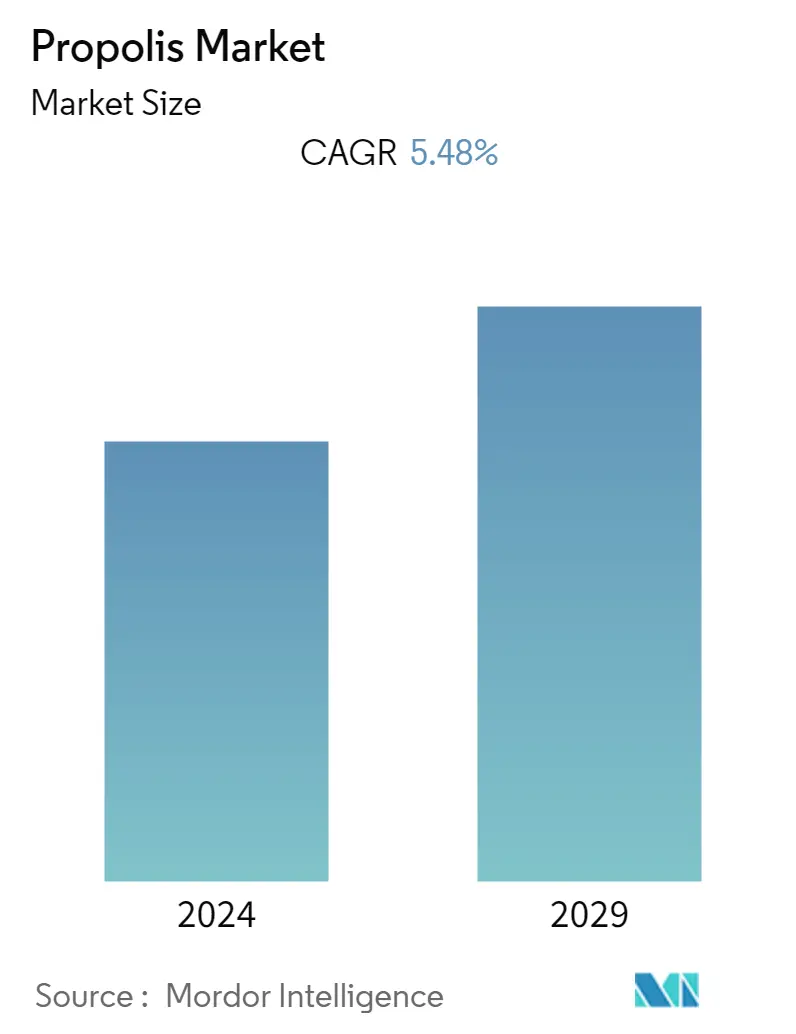Market Size of Propolis Industry

| Study Period | 2019 - 2029 |
| Base Year For Estimation | 2023 |
| CAGR | 5.48 % |
| Fastest Growing Market | Middle-East and Africa |
| Largest Market | Europe |
| Market Concentration | Low |
Major Players.webp)
*Disclaimer: Major Players sorted in no particular order |
Propolis Market Analysis
The Propolis Market size is expected to grow from USD 675.46 million in 2023 to USD 881.96 million by 2028, at a CAGR of 5.48% during the forecast period (2023-2028).
The COVID-19 pandemic led to the increased demand for propolis for its functional properties. However, the supply chain of the market studied was vastly affected by the falling production of propolis as an ingredient. The COVID-19 lockdown has presented a peculiar problem for beekeepers and bees. As countries go into extended lockdowns, the movement of non-essential vehicles has come to a standstill. Consequently, bee farmers found it difficult to move their bee boxes from one place to another, both cross-country and internationally, which resulted in bees starving to death; this reduced bee pollination and the production of propolis. Moreover, the availability of limited labor power further impacted the production of end products, negatively impacting the propolis market.
Over the long term, propolis intake strengthens the immune system, simultaneously serving as an antioxidant, anesthetic, and wound healer, which makes it an important component of the pharmaceutical sector.
One of the challenges while purchasing propolis is the lack of standardization across available brands. Many brands state they are made from 20% pure propolis. However, this does not inform the consumer of the quality of that 20%. Such a drawback in information transparency might restrain the growth of the market.
Propolis Industry Segmentation
Propolis or bee glue is a resinous mixture that honey bees produce by mixing saliva and beeswax with exudate gathered from tree buds, sap flows, or other botanical sources. The propolis market is segmented by product type, distribution channel, and geography. By Product Type, the market is segmented into Capsules and Tablets, Liquids, Creams, and Other Product Types. Based on Distribution Channel, the market is segmented into Offline Retail Stores and Online Retail Stores. The Offline Retail Stores segment is further sub-segmented into Supermarkets/Hypermarkets, Pharmacies and Drugstores, and Other Offline Retail Stores. Also, the report provides global insights into the propolis market in the major economies across regions, including North America, Europe, Asia-Pacific, South America, and Middle East & Africa. The market sizing has been done in value terms in USD for all the abovementioned segments.
| Product Type | |
| Capsules and Tablets | |
| Liquids | |
| Creams | |
| Other Product Types |
| Distribution Channel | |||||
| |||||
| Online Retail Stores |
| Geography | ||||||||
| ||||||||
| ||||||||
| ||||||||
| ||||||||
|
Propolis Market Size Summary
The propolis market is poised for significant growth, driven by its increasing application in the pharmaceutical and health supplement sectors. Propolis, known for its immune-boosting, antioxidant, and wound-healing properties, is gaining traction as a vital ingredient in various health and beauty products. The market's expansion is further supported by the rising consumer awareness of the health benefits associated with propolis, including its potential role in cancer prevention and its appeal as a gluten-free option for those with celiac disease. The demand for propolis is particularly strong in Europe, where health consciousness is on the rise. However, challenges such as the lack of standardization and transparency in product quality may hinder market growth.
The COVID-19 pandemic initially disrupted the propolis supply chain, affecting production due to logistical challenges and labor shortages. Despite these setbacks, the market is recovering, with manufacturers from countries like Brazil, New Zealand, and China scaling up production to meet global demand. The market is characterized by a fragmented landscape with numerous players, including Comvita Ltd, Wax Green, and Api√°rio Polenectar, who are leveraging strategic partnerships and brand promotions to enhance their market presence. Initiatives to certify products as organic and vegan are gaining consumer trust, further propelling market growth. As the elderly population increases and consumer interest in organic products rises, the propolis market is expected to continue its upward trajectory.
Propolis Market Size - Table of Contents
-
1. MARKET DYNAMICS
-
1.1 Market Drivers
-
1.2 Market Restraints
-
1.3 Porter's Five Forces Analysis
-
1.3.1 Threat of New Entrants
-
1.3.2 Bargaining Power of Buyers/Consumers
-
1.3.3 Bargaining Power of Suppliers
-
1.3.4 Threat of Substitute Products
-
1.3.5 Intensity of Competitive Rivalry
-
-
-
2. MARKET SEGMENTATION
-
2.1 Product Type
-
2.1.1 Capsules and Tablets
-
2.1.2 Liquids
-
2.1.3 Creams
-
2.1.4 Other Product Types
-
-
2.2 Distribution Channel
-
2.2.1 Offline Retail Stores
-
2.2.1.1 Supermarkets/Hypermarkets
-
2.2.1.2 Pharmacies and Drugstores
-
2.2.1.3 Other Offline Retail Stores
-
-
2.2.2 Online Retail Stores
-
-
2.3 Geography
-
2.3.1 North America
-
2.3.1.1 United States
-
2.3.1.2 Canada
-
2.3.1.3 Mexico
-
2.3.1.4 Rest of North America
-
-
2.3.2 Europe
-
2.3.2.1 United Kingdom
-
2.3.2.2 Germany
-
2.3.2.3 Spain
-
2.3.2.4 France
-
2.3.2.5 Italy
-
2.3.2.6 Rest of Europe
-
-
2.3.3 Asia-Pacific
-
2.3.3.1 China
-
2.3.3.2 Japan
-
2.3.3.3 India
-
2.3.3.4 Australia
-
2.3.3.5 Rest of Asia-Pacific
-
-
2.3.4 South America
-
2.3.4.1 Brazil
-
2.3.4.2 Argentina
-
2.3.4.3 Rest of South America
-
-
2.3.5 Middle-East and Africa
-
2.3.5.1 Saudi Arabia
-
2.3.5.2 South Africa
-
2.3.5.3 Turkey
-
2.3.5.4 Rest of Middle-East and Africa
-
-
-
Propolis Market Size FAQs
What is the current Propolis Market size?
The Propolis Market is projected to register a CAGR of 5.48% during the forecast period (2024-2029)
Who are the key players in Propolis Market?
Wax Green, Apis Flora, Apiário Polenectar, Innovations in Nutrition + Wellness and Comvita Ltd. are the major companies operating in the Propolis Market.

